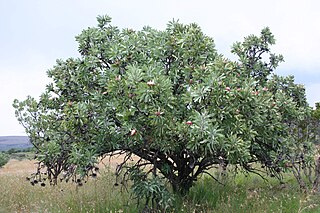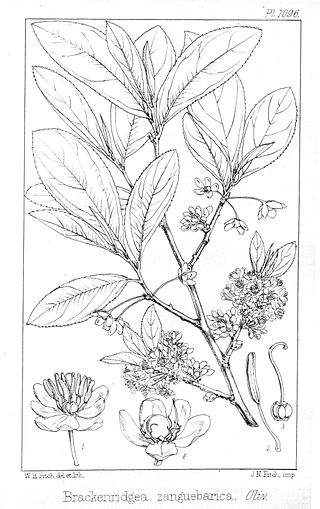
Ochna is a genus comprising 79 species of evergreen trees, shrubs and shrublets belonging to the flowering plant family Ochnaceae. These species are native to tropical woodlands of Africa, Madagascar, the Mascarenes and Asia. Species of this genus are usually called ochnas, bird's-eye bushes or Mickey-mouse plants, a name derived from the shape of the drupelet fruit. The name of this genus comes from the Greek word ὄχνη (ókhnē), used by Theocritus and meaning "wild pear", as the leaves are similar in appearance. Some species, including Ochna integerrima and O. serrulata, are cultivated as decorative plants.

Ochna integerrima, popularly called yellow Mai flower, is a plant species in the genus Ochna and family Ochnaceae. In the wild, it is a small tree or shrub species. The timing of the yellow flowers of this plant make it very popular in southern Vietnam, where plants are purchased during Tết.

Acer leucoderme is a deciduous tree native to the southeastern United States from North Carolina south to northwest Florida and west to eastern Texas. It lives in the understory in moist, rocky soils on river banks, ravines, woods, and cliffs. Although generally an uncommon tree, it is most often found in the inner coastal plain and Piedmont regions of Georgia.

Buddleja saligna, the false olive or bastard olive, is native to South Africa and Zimbabwe, where it has a wide distribution. It occurs most often in ravines and against outcrops, and is distributed from coastal elevations to the central plateau at elevations of < 2000 m. The species was first described and named by Willdenow in 1809.

Protea caffra, native to South Africa, is a small tree or shrub which occurs in open or wooded grassland, usually on rocky ridges. Its leaves are leathery and hairless. The flower head is solitary or in clusters of 3 or 4 with the involucral bracts a pale red, pink or cream colour. The fruit is a densely hairy nut. The species is highly variable and has several subspecies.

Dais cotinifolia, known as the pompom tree, is a small Southern African tree belonging to the Thymelaeaceae family. It occurs along the east coast northwards from the Eastern Cape, inland along the Drakensberg escarpment through KwaZulu-Natal and the Transvaal, with an isolated population in the Eastern Highlands of Zimbabwe. It flowers profusely during the summer months and produces a multitude of pink, sweet-scented, globular flowerheads about 10 cm across. Depending on the circumstances it can reach a height of up to 12m, although it rarely exceeds 6m in cultivation.

Dichapetalum cymosum, commonly known as gifblaar from Afrikaans, or occasionally by its English translation, poison leaf, is a small prostrate shrub occurring in northern parts of Southern Africa in the family Dichapetalaceae. It is notable as a common cause of lethal cattle poisoning in this region and is considered one of the 'big 6' toxic plants of cattle in South Africa. A 1996 estimate of plant poisonings in South Africa attributes 8% of cattle mortality caused by poisonous plants to it. The majority (70%) of fatal cases are in Limpopo province, with 10% each in North West, Mpumalanga, and Gauteng. Fluoroacetate, the poison used to synthetically produce Compound 1080 used extensively in New Zealand, occurs in all parts of the plant and is responsible for the toxic effects shown.

Ochna serrulata is an ornamental garden plant in the family Ochnaceae which is indigenous to South Africa. It is planted in southern African gardens and is an invasive species in Australia and New Zealand.

Ochna pulchra, also known as Lekkerbreek, is a small deciduous southern African tree up to 5 m, commonly found on deep sandy soil and rocky slopes, and belonging to the tropical family of Ochnaceae, which is widespread in Asia and Africa.

Celtis africana, the white stinkwood, is a deciduous tree in the family Cannabaceae. Its habit ranges from a tall tree in forest to a medium-sized tree in bushveld and open country, and a shrub on rocky soil. It occurs in Yemen and over large parts of Africa south of the Sahara. It is a common tree in the south and east of southern Africa, where the odour given off by freshly-cut green timber is similar to that of Ocotea bullata or black stinkwood.

Croton gratissimus, is a tropical African shrub or small tree with corky bark, growing to 8 m and belonging to the family of Euphorbiaceae or spurges. Young twigs are slender and angular and covered in silver and rust-coloured scales.

Euclea crispa, commonly known as the blue guarri, is an Afrotropical plant species of the family Ebenaceae. The hardy and evergreen plants may form a dense stand of shrubs, or grow to tree size. It is widespread and common in the interior regions of southern Africa, and occurs northward to the tropics. Though some are present near the South African south and east coasts, they generally occur at middle to high altitudes. It is readily recognizable from its much-branched structure and dull bluish foliage colour. Those bearing lanceolate leaves may however resemble the Wild olive, another common species of the interior plateaus.

Brackenridgea zanguebarica, the yellow peeling plane, is a species of plant in the family Ochnaceae. It is native to the southeastern Afrotropics. The bark of the tree is locally in high demand for traditional medicine.

Gardenia volkensii, commonly known as bushveldt gardenia or Transvaal gardenia, is a species of plant in the family Rubiaceae native to southern Africa.
Millettia usaramensis is a tree or shrub belonging to the family Fabaceae. It has two known subspescies namely, Millettia usaramensis subsp. australis and ''Millettia usaramensis subsp. usaramensis.

Ochna schweinfurthiana is a shrub or small tree belonging to the family Ochnaceae. It is represented in open deciduous woodlands in Tropical Africa.
Ochna rhizomatosa is a subshrub or shrub belonging to the family Ochnaceae, it is commonly found in West African savannah woodlands, from Guinea eastwards to Cameroon.
Ochna macrocalyx is a species that grows as a subshrub, shrub or small tree with yellow flowers arranged in axillary racemes and belonging to the family Ochnaceae.
Ochna holstii is an evergreen medium to large sized tree belonging to the family Ochnaceae.
Ochna membranacea is a shrub or small sized tree with yellow petals surrounded by red sepals belonging to the family Ochnaceae.













